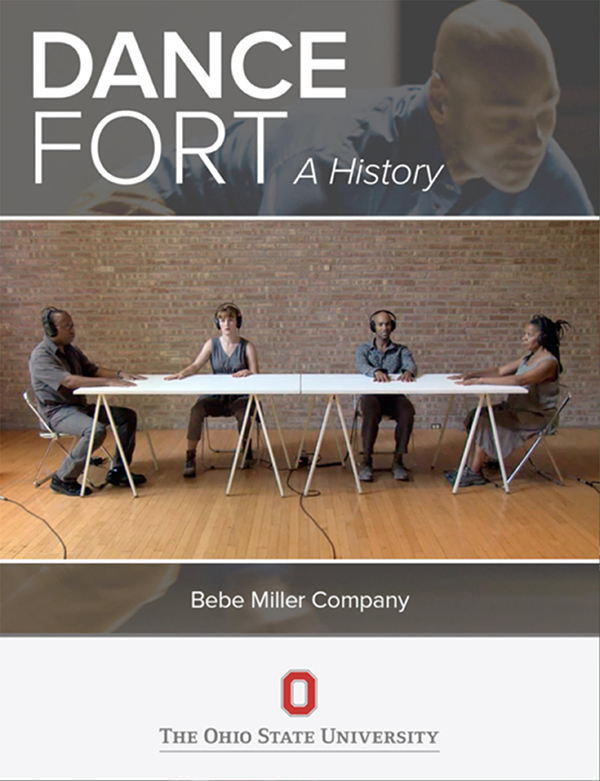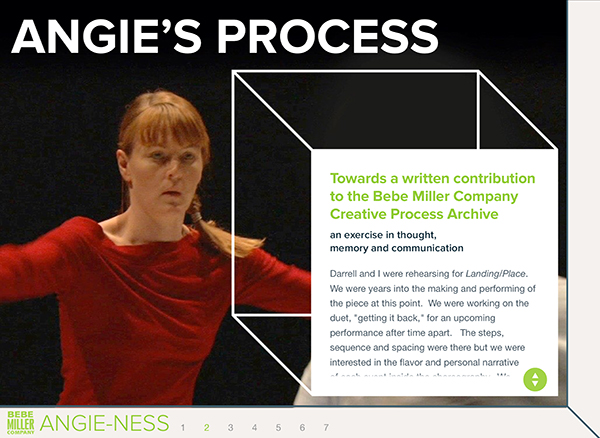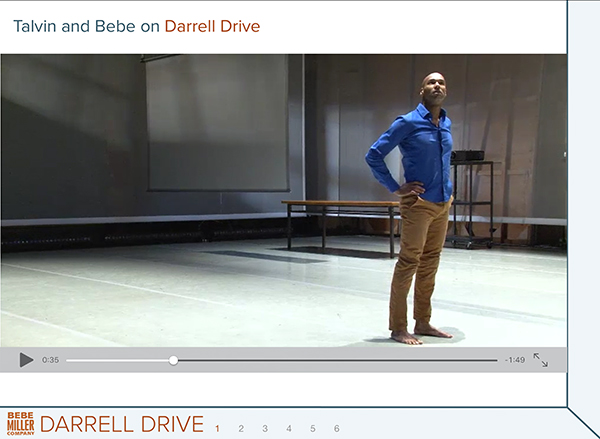Dance Fort: A History by Bebe Miller. 2015. Columbus: Ohio State UP. 49 pp with still images and video. Free iBook. iTunes.
Hannah Kosstrin, The Ohio State University
Keywords: artist-driven archive, documentation, Bebe Miller, iBook, iPad

Screenshot of the cover for Dance Fort: A History.
Choreographer Bebe Miller's iBook Dance Fort: A History enriches the landscape of artist-driven archives by presenting a digital platform that is at once a choreographic document and an interactive space for generative play. It is contemporary to the artist-driven Eiko & Koma Archive Project (2012-2013) and Jennifer Monson's Live Dancing Archive (2013) that feature dance makers' engagements with their choreographic pasts, and to web-based media such as MotionBank's TWO (2013) that use dances' choreographic structures for creative inquiry. Miller intends Dance Fort to be "a means to share company process and methodologies with the dance field, artists in other disciplines and the general public."1 Developed alongside Bebe Miller Company's collaborative dance A History (2012) as its digital chapbook companion, Dance Fort teaches the reader how to be with A History while serving as a repository for the collaborators' own understandings of the work. Comprised of a curated collection of artifacts from Company members—Miller, performers Angie Hauser and Darrell Jones, dramaturg Talvin Wilks, videographer Lily Skove, installation artist Maya Ciarrocchi, and embedded archivist Rachael Riggs-Leyva—Dance Fort features collaborators' notes, sketches, emails, and reflections from during and after the rehearsal process, video clips from process and performance accompanied by collaborator voiceovers, and clarifications from the collaborators as to their conceptions of the work from within. Acting both as a record and as a way to understand the inner workings of the dance, Dance Fort mirrors A History, which was a way for Miller to unveil the lived experiences of her company through the past fifteen years. Dance Fort disassembles A History and focuses on its underlying choreographic concepts, helping readers to understand it from the inside out.
As a theatrical work based on a series of improvisational scores, A History is about "storyness," which Miller defines as the way dances make meaning. "Storyness" is, she asserts, "an exploration of intention and focus that feels like history and future are both at play."2 As a digital book, Dance Fort follows a "storyness" structure as it introduces a guided path through the book along with the ability to jump around from part to part. It invites the reader into an improvisational score that unfolds the various ways in which A History means.
Answering the task of how one performs an archive, for A History the Company mined its own kinesthetic past through the choreography in Verge (2001), Landing/Place (2005), and Necessary Beauty (2008), including the collaborators' bodily histories of their past experiences performing together. As I watched A History, whispers of Bebe Miller Company's past entwined with my own as I remembered seeing these works live—a duet from Verge, a headstand from Landing/Place. I, too have a history of experiencing Miller's work through time. And, one could argue, our understanding of contemporary dance and our place in the world in relation to it comes from carrying our own kinesthetic and empathetic histories along from our experiences of one dance performance to the next. Dance Fort makes these connections visible. Miller explains: "Dance Fort began as a conversation: we were wondering how (and if) audiences could locate the threads of related ideas and questions that were foundational to our creative practice but not so visible in the dances themselves."3 Each collaborator's distinct understanding of the work surfaces through reading and hearing their reflections in Dance Fort. It then becomes clear how A History's threads wind into a larger opus that is both the sum of its parts and a larger equation that accounts for relationships within the work and their ability to signify multiply. As in Miller's dances, meaning in Dance Fort emerges through sensory imagery, text, and a manipulated sense of time—a humid and embodied recall that manifests layers of memory as it plumbs the human condition.


Screenshots. “Angie-ness” and “Darrell Drive” from Dance Fort: A History.
Dance Fort contains three sections in addition to a preface and credits: "Tracking the Process," "Angie-ness" (the way Hauser performs and makes decisions while dancing), and "Darrell Drive" (Jones' impetus that manifests in his dancing). Still and moving images effectively ground the iBook's visual narrative, and hyperlinks in the book connect readers to web resources like collaborators' personal websites. The most effective linked resource is a Vimeo-hosted full video of the 75-minute A History performed at LIU Brooklyn's Kumble Theater for the Performing Arts on April 12, 2013, followed by a post-performance discussion with Miller, Hauser, and Jones moderated by dance critic Eva Yaa Asantewaa.4 The full video offers readers a deeper experience with the dance as they progress through Dance Fort. While it is sometimes physically tricky to find one's place inside the fort beyond swiping back and forth, the book's intellectual mapping allows for slippage to read each part more or less in any order.
Dance Fort speaks to a group of digital media publications that include artist-driven archives and iPad-based books about contemporary dance. As a digital book about the process of one dance, Dance Fort recalls Merce Cunningham Event, an iPad app by the performing arts journal 2wice (2011).5 As differentiated from other Apple-based dance iBooks and apps, such as David Vaughan's Merce Cunningham: 65 Years (2012), or Marc Raymond Strauss and Myron Nadel's Looking at Contemporary Dance (2012), Dance Fort pushes the platform beyond the inclusion of video and links and relies on the user's gestural interactions with videos as generative of its explanations. Dance Fort capitalizes on the iPad platform by making sense of swiping between screens with small annotations or internal scrolling features for individual artifacts. This translates easily to computer viewing with gesture-based devices like a trackpad or the Apple "magic mouse."
As dance documentation tools continue to shift, Dance Fort provides a dynamic way of getting inside the dance without losing sight of the work itself. It provokes productive questions about best practices for engaging with dances outside the theater and what kinds of records are best fitted to choreographies in terms of their process and product. It is a resource for artists, teachers, and students, as well as scholars of contemporary dance, modes of documentation, digitality, and dance on screens.
Biography
Hannah Kosstrin, Ph.D., is Assistant Professor in The Ohio State University Department of Dance and is affiliated with the Melton Center for Jewish Studies. She is finishing a book about Anna Sokolow for Oxford University Press, has published in Dance Research Journal, Dance Chronicle, The International Journal of Screendance, and Dance On Its Own Terms: Histories and Methodologies, and is project director for the Labanotation iPad app KineScribe. Kosstrin is Treasurer of the Congress on Research in Dance, and is a member of the Society of Dance History Scholars Editorial Board and the Dance Notation Bureau Professional Advisory Committee.
Email:
References
2wice: Merce Cunningham Event. New York: 2wice Arts Foundation, Inc., 2011. iPad App.
Merce Cunningham: 65 Years. David Vaughan. New York: Aperture Foundation, 2012. iPad App.
Eiko & Koma. Eiko and Koma: Archive Project. Accessed February 12, 2016. http://eikoandkoma.org/archive.
Miller, Bebe. Dance Fort: A History. Columbus: Ohio State UP. 2015. iBook.
Monson, Jennifer. Live Dancing Archive. 2013. Accessed February 12, 2016. http://www.livedancingarchive.org.
Palazzi, Maria and Norah Zuniga Shaw. TWO. The Ohio State University's Advanced Computing Center for the Arts and Design and Motion Bank, 2013. Accessed February 12, 2016. http://scores.motionbank.org/two.
Strauss, Marc Raymond and Myron Nadel. Looking at Contemporary Dance: A Guide for the Internet Age. Princeton, NJ: Princeton Book Company, Publishers, 2012. iBook.
